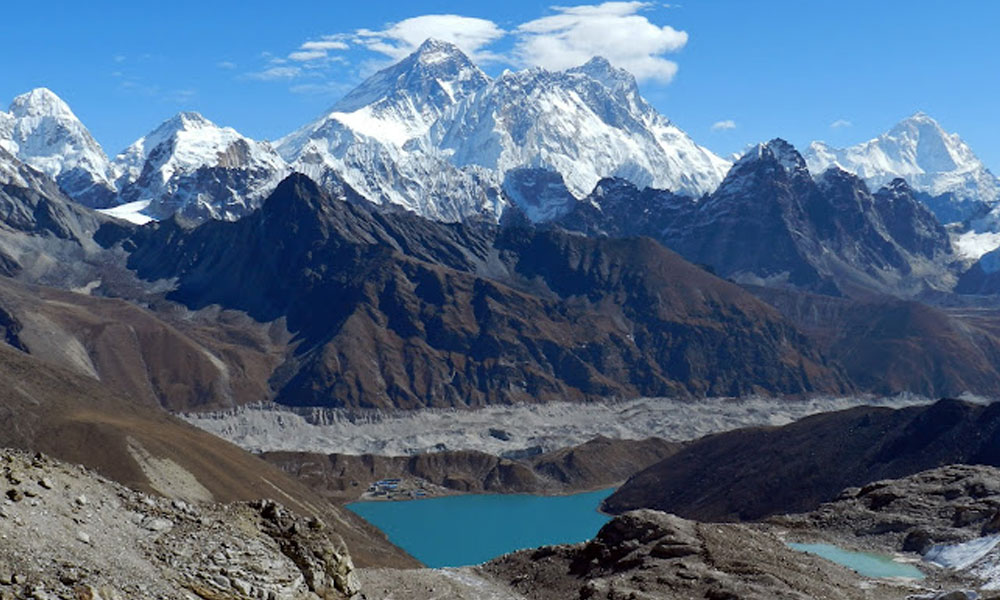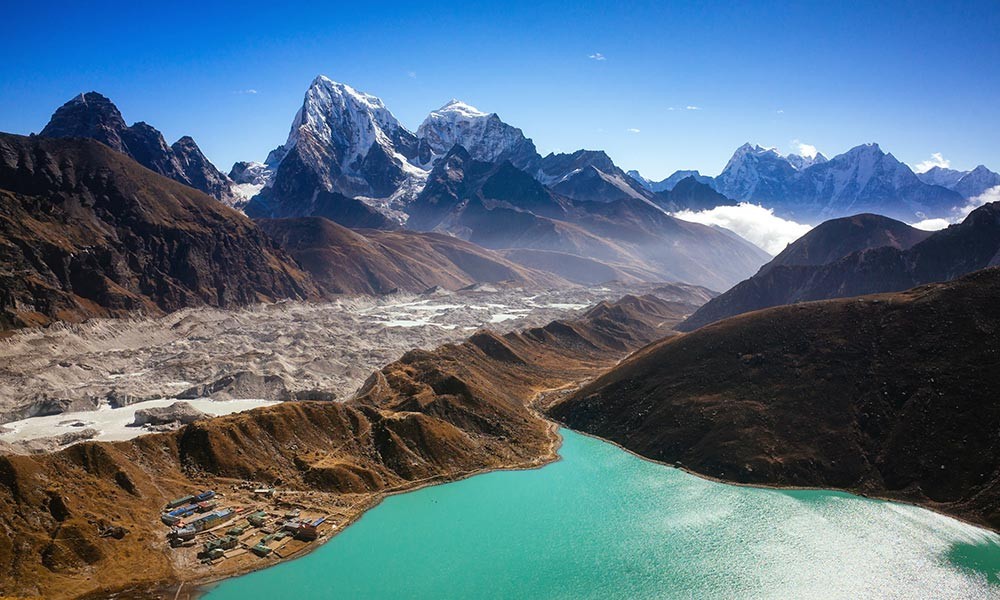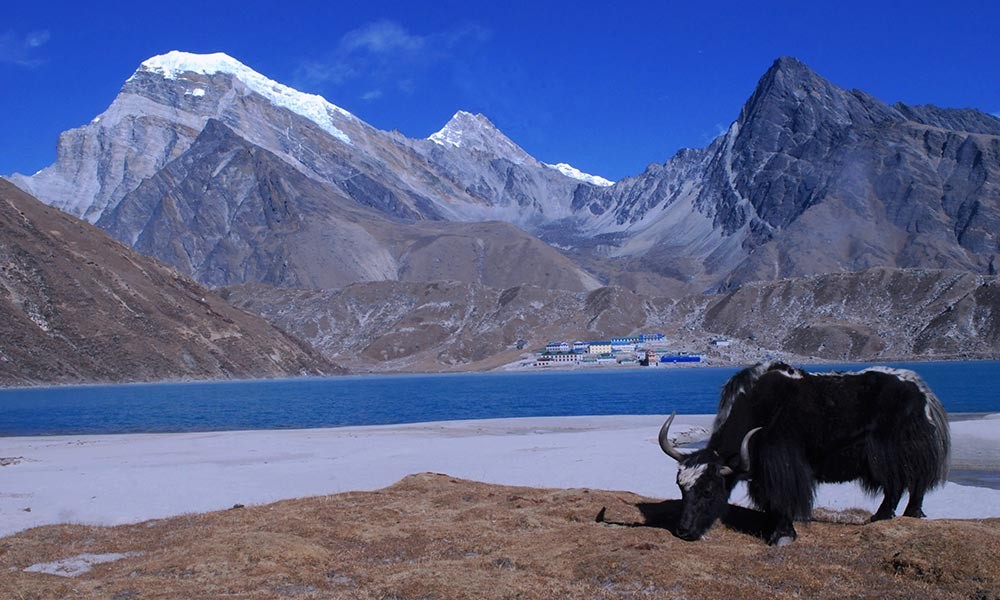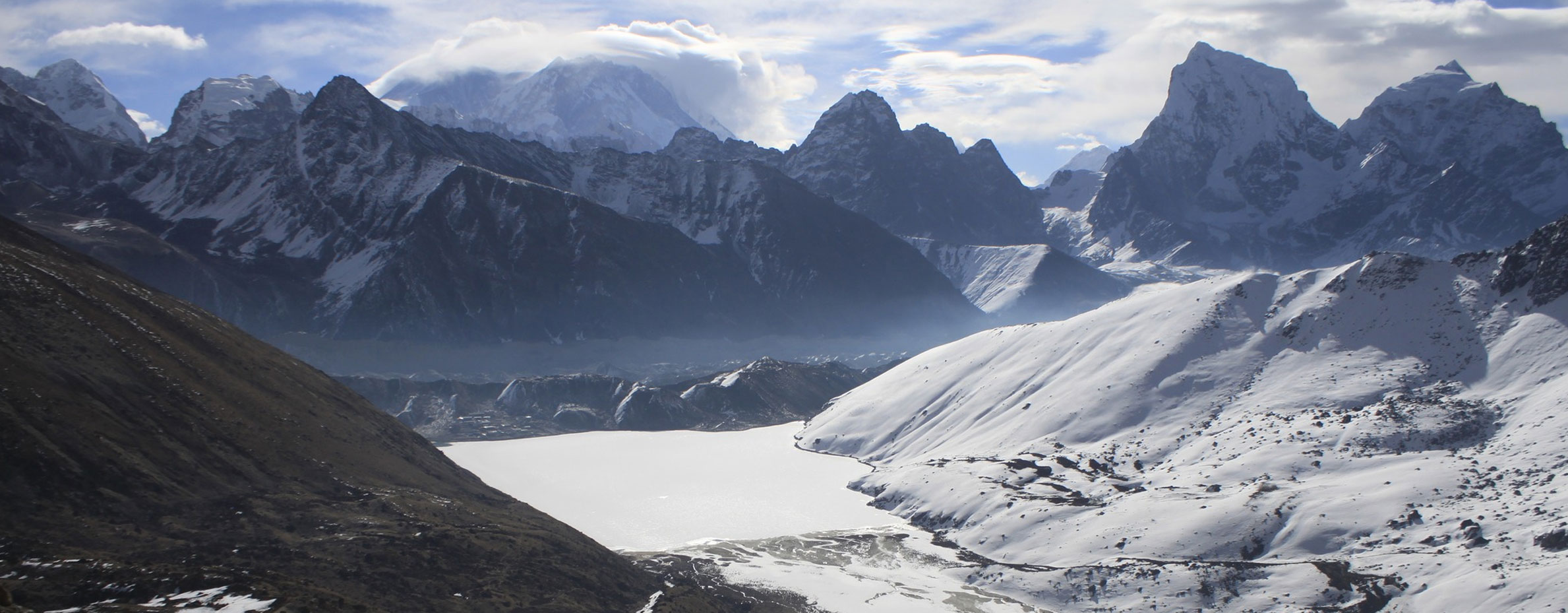
Gokyo Lake Trek is a thrilling exploration of the pristine sacred lake, Gokyo (4,750 m). This demanding trek can be considered a moderately challenging journey. If you are thinking of embarking on the Gokyo Lake Trek, you are likely to be curious about its difficulty level. The Gokyo Lake It is not hard compared to other treks in the Everest region, which incorporate tough and demanding trails. Although Gokyo Lake Trek is accessible to adventurers of varying skill and experience levels, it still presents a significant test of your endurance, acclimatization, and trekking expertise.
Gokyo Lake Trek is an averagely difficult, high-altitude adventure with non-technical trekking trails. However, some sections of trekking trails are rugged, steep, and narrow passes, which challenge your skill and capability to the core. If you are physically fit without any health complications and carry essential stamina with endurance capacity, you can overcome the toughness of the trek. Although the trek involves no technicalities, altitude can be a problem. You will be staying over 3,000 meters for several days during the trek. Also, the trek reaches the highest elevation above 5,000 meters. At such high altitudes, there is the possibility of altitude sickness due to reduced oxygen as of thinner air.
This Turquoise-blue lake is of great importance to both Buddhism and Hinduism. The soulful journey on the laps of the gratifying mountains leads you to the Gokyo Lake in Gokyo Valley. The adventurous trekking routes pass amidst the foothills of the sky-reaching Himalayan peaks. Moving along the rugged trails of remote mountainous landscapes, the off-beaten paths lead you through Phakding, Namche, Dole, Machhermo, and ultimately onto the Gokyo Lake. While traversing the diverse Himalayan terrains, you can observe dominating mountains from various points along the trek.
The Gokyo Lake Trek meets its highest point at Gokyo Ri, 5,357meters/17,575 feet, from where you can marvel at the stunning panorama of the prominent peaks of the Mahalangur subrange Himalayas like Everest (8,848 meters/29,029 feet), Makalu (8,485 meters/27,838 feet), Lhotse (8,516 meters/27,940 feet), Cho Oyu (8,188 meters/26,864 feet), Cholatse (6,440 meters/21,129 feet), Taboche (6,542 meters/21,463 feet) and several other adjacent mountains.
Setting out for the Journey

Pack your bags and tie your bootlaces to set out for the incredible Himalayan treks of the Gokyo Lakes. But, before setting foot on the trails, a thorough reparation with cautious planning is vital for a safe and joyful journey. Every trek requirement must be carefully packed, like permits, first aid items, clothing, trekking gear, etc. As a seasoned trekker, I embarked on this epic journey, reviving myself for the challenges and rewards that awaited along the trails. Because this was my first trek to the lake, I had a question: how hard is the Gokyo Lake?
Obtaining Gokyo Lake Trekking Permits.
It is crucial to obtain the necessary permits in order to embark on a particular trek. For Gokyo Lake Treks, you can get the required permits from the Nepal Tourism Board or the Sagarmatha National Park authorities. A total of three permits are required for the Gokyo Lake Trek, which are:
- TIMS Card - NPR 2,000/15 UD$
- Sagarmatha National Park Entry Permit - NPR 3,000/23 US$
- Khumbu Pasang Lhamu Rural Municipality Entrance Permit - 20 US$ per week
Permits ensure compliance with local regulations and even contribute to regional conservation efforts. With permits in hand, I was ready to embark on my adventure into the Himalayan core.
Packing Trek Essentials

Packing requires careful consideration because the high-altitude environment faces several challenges. The terrain is mostly rough and rugged, and the weather is not static, changing frequently. Warm dresses are mostly required as per the cold Himalayan conditions. But the daytime temperatures at favorable trekking seasons need some light clothes for trekking.
It is obvious that you should embark on the best seasons, spring and autumn, which serve as a healing balm in Gokyo Lake Trek difficulty. So, it is better to follow a layered approach to clothing, which can be easily worn to shield against the cold and can also be easily taken off if you feel burning.
Also, pack sturdy trekking boots that give the best ankle support. Consider boots that are a bit larger than your actual shoe size. This is because if the boot doesn't house enough space for fingers or whole feet, there is a chance of swelling and pain. A good pair of trekking boots is always helpful in making your every walk on the rugged mountainous trails comfortable, reducing blisters and injuries.
Do not forget to pack the necessary trekking gear like trekking poles, headlights, and other essentials like cameras, smartphones, general medications, water bottles, personal hygiene items, etc. Everything that you pack plays a necessary role in enhancing your safety and comfort during the trekking journey. For my journey, I packed altitude sickness medication, a Diamox tablet, and my preferred snacks to recharge my energy level for the adventure.
Embracing the Himalayan Trails - Gokyo Lake Trek Challenges

After landing in Lukla from a Kathmandu flight, the trekking journey begins forward, embracing the Himalayan trails. The initial trek from the gateway of the Everest region (Lukla) to Phakding and from Phakding to Namche Bazaar greets you foremost with the fresh mountain chill. Upon reaching the lively town of Namche Bazaar, you can experience the vibrancy of the bustling streets and markets. At Namche Bazaar, I was excited to see other fellow trekkers preparing for their own adventures.
Here, you will be at 3,440 meters above sea level, which can pose altitude challenges. Altitude sickness is one of the major difficulties of Gokyo Lake Treks, with symptoms of headache, nausea, fatigue, vomiting, dizziness, sleeplessness, low appetite, rapid heartbeat, breathing difficulty, etc. So, be wary of these occurrences and follow a slow pace of trek.
Next, you will follow a winding mountainous trail, making your way through charming local villages and lush forests with a glorious taste of forthcoming adventures.
Dudh Koshi River/ Suspension Bridge Crossing
Crossing the Dudh Koshi River along the Gokyo Lake trekking trails can be a challenge for unfamiliar trekkers. You have to trek over the sweeping suspension bridge, overcoming the fright of precarious swing with each step. The suspension bridge crossings are indeed exciting and fascinating; however, you need a steady focus for safe and enjoyable navigation. The suspension bridge spanning over the fast-flowing water of Dudh Koshi River tested my balance
Rollercoaster Terrains
You will have to take several ascends and descends during the Gokyo Lake trekking journey. This rollercoaster of uneven mountainous terrains tests your strength, stamina, and endurance capabilities. Natural rocky trails and narrow passes are the basic characteristics of trails during high-altitude Himalayan trekking. Trekking over the paths narrowly curved into the hillslope presents a jaw-dropping scenario of the beneath terrains. Likewise, the continuous steep uphill and downhill paths of loose rocks section unfold layers of obstacles to overcome for the journey. This part of the walk demanded concentration and careful walking.
Meeting New Heights
Ascending to higher elevations, on each tread, you will continue to gain new heights. Landscapes begin to transform into more rugged scenery with steep ice and rocky terrains. With each passing day, the Gokyo Lake Trek difficulty intensifies. However, on the other hand, overcoming the challenges, moving forward continuously, and finally reaching a new height provides you with a scene of accomplishment and achievement. You can relish the spectacular scenery from each new elevation you achieve during the journey.
Also, when trekking into the mountainous height, atmospheric air starts to decrease and becomes more thinner and thinner. This is a problematic situation because if you are not well-prepared or habitual to the alpine environment, you may soon catch altitude sickness. So, beginner trekkers who are unfamiliar with higher altitudes should take enough time to acclimatize. Acclimating to the changing/rising elevations of the trek prepares the body to adjust to the environment and eventually makes the journey easy and comfortable.
Reaching Turquoise Gokyo Lake

Navigating the hard alpine topographies, you can finally marvel at the turquoise Gokyo Lake. The mesmerizing Gokyo Lake is encircled by the majestic Himalayas. The harmonious blend of pristinely sparkling glacial water of the Gokyo Lake and its encircling snowy peaks create an enchanting sight that heals your heart. The turquoise reflection of the mint lake into the eyes of the beholder captive the senses. This soothing lake offers a tranquil moment of respite in between the rugged Himalayan terrains. As soon as I dipped my tired feet into the cool lake waters, I could feel the tranquility rushing over me. It was a pure moment of happiness and pleasure after a long, tiring trek.
Note: The lake is called turquoise, referring to its amazing blue-green color. The feeding of glacier sediment to the lake by means of the melting glacier is gathered beneath. These sediments reflect the sunlight, giving the water its unique turquoise color.
Duration Taken and Distance Covered
In general, the Gokyo Lake Trek takes around 11- 15 days to complete while covering an approximate distance of about 80 - 90 kilometers in total. Each day of trekking involves several hours of walking on hard mountainous trails. The altitude during the entire journey ranges from 2,800 meters in Lukla to over 5,000 meters in Gokyo Ri.
As you will be trekking through the less-trodden paths, the trails can be challenging to navigate. Mostly at higher altitudes, the steep trails with uphill and downhill sections can trouble you if you are a novice trekker. Duration contributes to the difficulty level of a trek because you may have to walk around 5 to 6 hours daily, excluding the acclimatization days. So, be conscious of choosing the itinerary because more trekking days are easier than fewer ones. This is because you have to walk for only a few hours every day, with more acclimatization days.
Accommodation Challenges

Along the journey, accommodation opinions are widely available, from simple teahouses with basic amenities to well-established lodges. Although the facilities and services were basic in teahouses, the authentic hospitality of the local sherpa people provided warmth to my heart. Cozy teahouse accommodations, along with the welcoming and charming nature of the residents, offer a relaxing break after long hours of everyday trek.
Since I trekked during the peak time of Autumn, in the month of October, there were a huge number of trekkers. It was a bit tough to find proper accommodation for me. Hence, I suggest you book the accommodations in advance before going out on the trek in peak seasons. Or, if you are trekking through a licensed trekking agency, you don’t have to worry about a thing, as they will make necessary reservations.
Off-season Challenges.
June to August in summer and December to February in winter are the off-trekking periods. A journey during the off seasons encounters you with several challenges. As a result, you cannot fully enjoy your trek. So, let's analyze how tough it is to trek the Gokyo Lake during the off-seasons, summer and winter.
How Hard is the Gokyo Lake Trek in Summer?

The summer/monsoon season brings heavy downpours. This makes the trekking trails wet and slippery. It is challenging to traverse the rough and rugged Himalayan trails on these slippery trails. Moreover, steep sections are incredibly hard to tackle. Heavy rain also results in the risk of landslides and avalanches.
The rain in forest regions and grassy routes creates a problem of leeches. Trekking on the leeches-infected trails is troublesome. But you can carry salts and insect repellents to deal with leeches along the trek. Though there is a solution, the journey can still not be as satisfying as walking on dry and clean trails.
In addition, the hot and humid temperatures, especially in lower trekking regions, add challenges to the journey. So, enough time for rest, relaxation, hydration, and acclimatization is crucial.
How Hard is the Gokyo Lake Trek in Winter?
During winter, there is frequent heavy snowfall. So, you have to trek over the thick layer of snow-blanketed trails. Such is the condition, mostly in higher altitude trekking regions. Your trekking pace can slow down walking with heavy boots. Snow accumulation can even block the trail passes, leading to further difficulties.
Moreover, the alpine region is extremely cold, and Gokyo Ri can be almost frozen around this time of year. You need warm clothes to remain cozy and outer shells to shield against the snowstorms, which are quite common in winter.
When is the Best Time for the Gokyo Lakes Trek?

The best times for the Gokyo Lake Trek are during the autumn and spring seasons. Not only for this particular trek, the autumn and spring seasons are the most favored times for every high-altitude trekking adventure in the Himalayas.
Choosing the ideal trekking time will help minimize the difficulty of the Gokyo Lake Trek. Spring and autumn seasons characterize stable weather conditions and moderate temperatures. You can have enhanced and unobstructed observation of the most outstanding snow-capped Himalayas against the background of deep blue, cloudless skies. Also, there is less precipitation, making the trek easy and comfortable on dry trails.
The spring months of March and April are the scenic times for trekking in the Gokyo Valley. The trekking trails are covered with rhododendron blossoms. The vibrant forests are all decorated with different shades of blooming Himalayan wildflowers. Every tread on the trails feels like you are walking around a fairyland!
Note: Gokyo Lake Trek is doable at any time of the year with cautious planning, thorough preparation, and proper packing of the trekking gear and clothes.
Tips to Overcome Gokyo Lake Trek Difficulty

Despite the challenges, there are always ways to minimize the difficulties of the trek to make the journey simpler and more enjoyable, even for inexperienced trekkers.
- Always choose the favorable trekking seasons, like Spring and Autumn. There are no extreme weather complications due to a stable climate, moderate temperatures, and clear skies during these seasons. You can relish your trek in delightful environmental conditions.
- Beginner trekkers should consider taking a licensed guide and porter for the journey. Guides help you navigate unfamiliar trekking routes, and porters aid you in carrying your backpack loads, both allowing you to have a free and joyful trek.
- Only pack the most required trek items in your backpack. Overpacking increases the baggage weight, which can lead to fatigue.
- Consider taking enough days for acclimatization during the trekking journey. This helps you to properly acclimatize to the altitude/surroundings and reduce the risk of altitude sickness.
- Train yourself before the trek by getting involved in physical exercises. The generated strength and flexibility prepare you for a smooth and efficient trek.
- You can engage in cardiovascular activities like hiking, swimming, cycling, jogging, etc. Also, emphasize leg exercises for strength, stamina, and endurance to overcome the rugged and steep terrains.
- Take regular hydration breaks because drinking adequate water/fluids keeps you out of illness and altitude sickness. Stay healthy by eating nutritious food.
Disclosure of the Journey

As the trekking journey is pushed toward the end, you will undoubtedly have a profound sense of gratitude to nature for the deeper connection and memorable experience gained. Also, you can gladly hold pride in accomplishing the trek despite challenges, which are seamlessly dealt with. This incredible journey is a testament to the beauty and greatness of the pristine Himalayas. Moreover, it is the determination and resilience of trekkers who dare to explore the rugged alpine terrains of the particularly remote regions. At times, the trekking can be tough and challenging, but the rewards achieved thereafter are precious and incomparable.
Also, you get to immerse yourself in the deep learning of the Himalayan cultural heritage. As per my own experiences, the Gokyo Lake Trek pushed my limits both mentally and physically. Although I had made careful planning and prepared well for the worst, the trek was not far from challenges. Uncertain weather changes and altitude sickness were common challenges. With determination, I brought myself so far to conquer the adventure through the toughest situations. I pulled the strength out of the breathtaking scenery that encircled me during each day of the hard Gokyo Lake Trek. As a result, I got to enjoy the moments of unbeatable beauty and peace in this Himalayan adventure.

